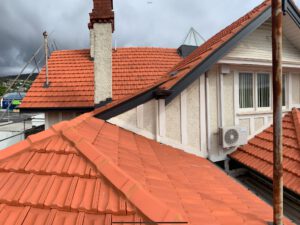The roof is an important part of any house or building. It protects the inhabitants from rain, snow, sunlight, and extreme temperatures.
A roof can be constructed in many different ways. Some are flat, and others are sloped. It’s important to know what kind of roofing structure you have so you can choose the right materials for it. Contact Roofing Columbus GA for professional assistance.
A roof’s style is more than just a design element; it plays an important role in a building’s energy efficiency, attic space, maintenance needs, and even its value. It also has a big impact on the overall aesthetic of a home’s exterior and is exposed to harsh weather elements including sun, rain, snow, and wind.
There are a variety of different roof types that you can choose for your home. These are based on the materials used to make them, how they are put together, and their frame or structural design. There are also some types that are specific to the region you live in, such as a butterfly roof, saltbox, or mansard.
Tiles are made from organic materials like clay, concrete, and slate, often fired in a kiln. They are highly durable and can last up to 100 years with proper care and periodic maintenance. They are also heavier than other roofing materials, such as shingles, and require professional installation.
Gable roofs are the most common type of roof and feature two slopes meeting at a ridge on top, creating a triangle-framed structure. You can customize the look of this roof by changing the steepness of the slopes, adding gablets to increase attic space, or adding windows for more natural light.
A flat roof is one that is extremely low-sloped to allow for water runoff. It’s a popular choice for modern-architecture homes and works well with open floor plans. Flat roofs are prone to leaks and need routine maintenance to ensure sealants stay intact.
Metal roofs are long-lasting and come in a range of styles, from standing seam to shingle look-alikes. They’re resistant to the elements (fire and rot) and are also energy efficient.
A tar and gravel roof is a popular choice for flat or low-pitch roofs because it helps keep the water away from your home. It consists of layers of paper, tar, and liquid asphalt that are spread out to cover the roof and topped with finely crushed rock that is pressed into it while still hot.
Flat Roofs
Flat roofs are commonly seen on commercial buildings, but they can also be found on residential homes. This type of roof has a number of benefits, including lower upfront costs and easy repairs. However, there are some disadvantages to flat roofing, such as the risk of water damage if maintenance is not carried out regularly.
Unlike sloped roofs, flat roofs have a shallow slope that allows rainwater to easily flow off the surface. They are also designed with a drain system that channels water away from the home or building. If there are problems with the drainage system, the water may pool on the roof for extended periods of time, which can lead to structural damage and even flooding in the basement.
If you have a flat roof, it is important to have regular inspections and maintenance done by a qualified professional. This will help to ensure that the waterproofing membrane is intact and that there are no cracks or leaks. Additionally, it is necessary to keep the roof free of debris, especially leaves and branches. If these items are allowed to build up on the flat roof, they can cause the waterproofing materials to become damaged and eventually leak.
Another issue with a flat roof is that it does not drain as well as a sloped roof. This can be a problem if there are long periods of time without rain or snow. It is also important to install a gutter system on the flat roof and to properly channel rainwater into it so that it does not pool on the surface.
Finally, a flat roof can be difficult to walk on. This is especially true if it has a surface made of a material such as rubber or bitumen. This can lead to serious injuries if you fall off the roof. However, it is possible to use a different type of roof covering, such as PVC or polycarbonate, that will be able to withstand foot traffic. In these cases, the flat roof can be used as an outdoor space for a garden, air conditioning units, or solar panels.
Agable Roofs
Whether you are building a new house or remodeling your current residence, gable roofs provide excellent protection and add beauty to any home. These roofs are easy to construct and have a variety of design options to enhance your living space. They are also relatively inexpensive to install compared to other roofing styles and can be built from a wide range of materials, including asphalt shingles, wood, and metal.
The gable roof’s A-shaped structure easily sheds snow, rain, and other weather elements. Its steep pitch helps drain the roof and prevent water accumulation, which can cause severe damage to your home’s structure and contents.
This roof’s shape is also ideal for allowing air to escape through gable vents or ridge vents, keeping the attic and the rest of your house cool and dry. This is especially important in areas with hot summers and rainy seasons. This ventilation also helps prevent mold, mildew, and rot in the attic and other areas of your home.
One of the biggest pros of gable roofs is that they provide ample attic space for storage or even additional living space if you insulate them properly. This space is especially useful for storing holiday decorations, according to Diversified Roofing. It’s also a great place to store children’s toys or other belongings that might otherwise clutter the living area.
Moreover, gable roofs are easy to access for maintenance and repairs. This makes it easier for you to replace shingles that are worn or damaged. You can also replace gutters, which are essential for directing rainwater away from your home’s structure and into storm drains.
Another big pro of gable roofs is their energy efficiency. A well-insulated gable roof can keep your home cooler in the summer and warmer in the winter, saving you money on energy bills. The angled or sloped sides of your roof can help reflect heat and UV rays, keeping your house warm without relying on the HVAC system as much. This will also save you money on your electricity bill and help the environment as well.
Metal Roofs
You may not notice them when driving down the street, but look up, and you’ll see that a growing number of houses and buildings have metal roofs. Though often associated with barns and industrial settings, metal roofs work well in residential applications as well and can be designed to resemble other roofing materials like shingles or clay tile. The wide range of colors and styles available makes it easy to find a style that complements your house and the surrounding environment.
There are several different types of metal roofs, each with its own unique advantages and drawbacks. Standing seam metal roofing, for example, is one of the most durable and weather-tight roofing systems. It’s also expensive.
It’s important to have your metal roof regularly inspected and maintained to ensure it performs as it should. This includes removing debris that can trap water on the roof, such as fallen branches and leaves. The roofing system should also be inspected after any significant weather events to check for any damage.
Most homeowners choose to have a metal roof because it’s low-maintenance and can last decades. It’s also fire-resistant and has an attractive appearance. Some metals, however, rust in certain climates and can dent easily during hailstorms.
If you’re considering a metal roof, talk to a professional roofing contractor to discuss the best options for your climate and design preferences. The type of panels used will determine how your roof looks, and the way they are seamed together will affect how weather-resistant it is. For instance, cool-panel metal roofs are better for areas that experience high heat, while corrugated panels are great for rainy regions.
Other types of metal roofs include mechanical lock panels, snap-lock panels, and exposed fastener panels. With mechanical lock panels, the metal panels are interlocked with clips to make them stand up vertically. In contrast, snap-lock panels have the male leg of each panel snapped over the female leg of another panel to connect them. These clips are then hidden by the next sheet of metal.
Whether you’re choosing an exposed fastener or concealed system, it’s essential to use a good-quality metal that is thick enough to withstand the climate where you live. The thickness of the metal will determine how well your roof holds up in extreme weather and if it can resist corrosion. It’s also critical to have the right underlayment and sealants. Avoid tubes of home-center silicone; instead, invest in a high-quality polyurethane sealant that’s made to adhere to metal and flex with it.
